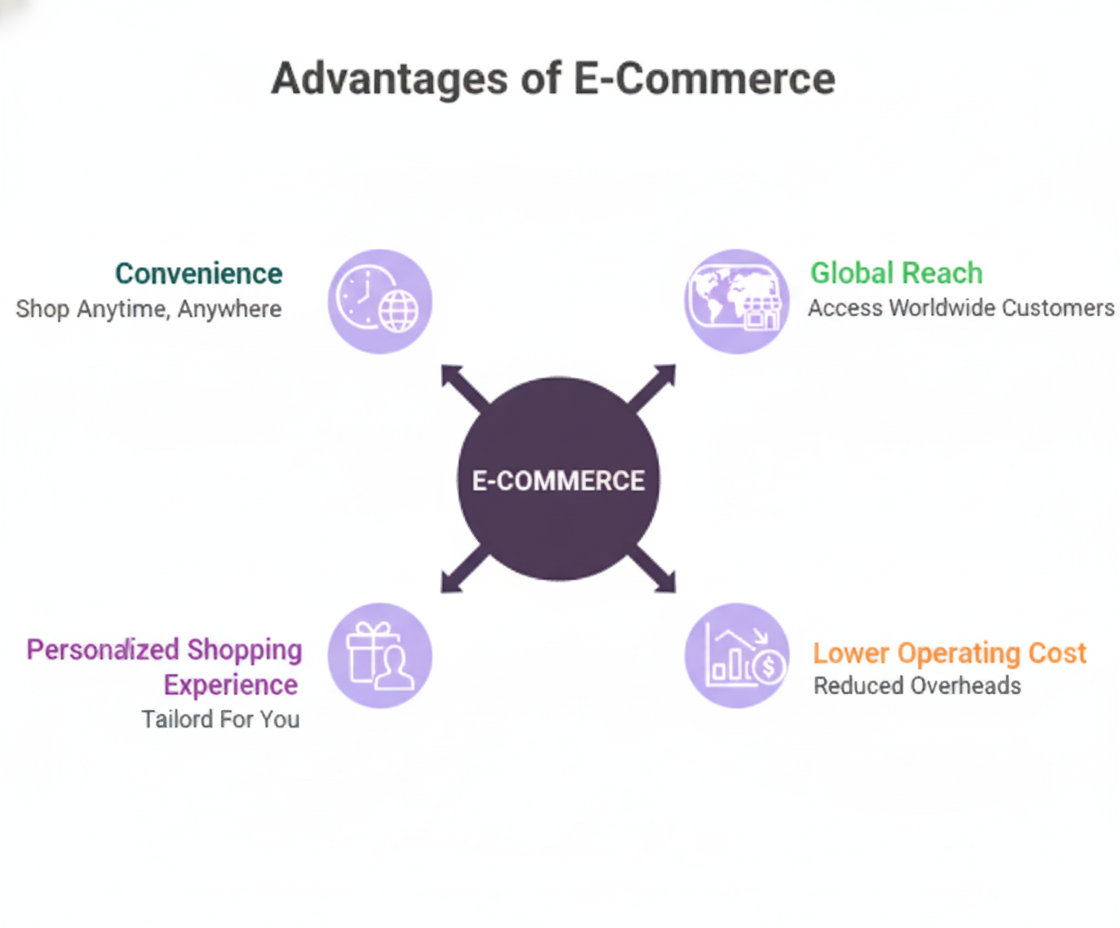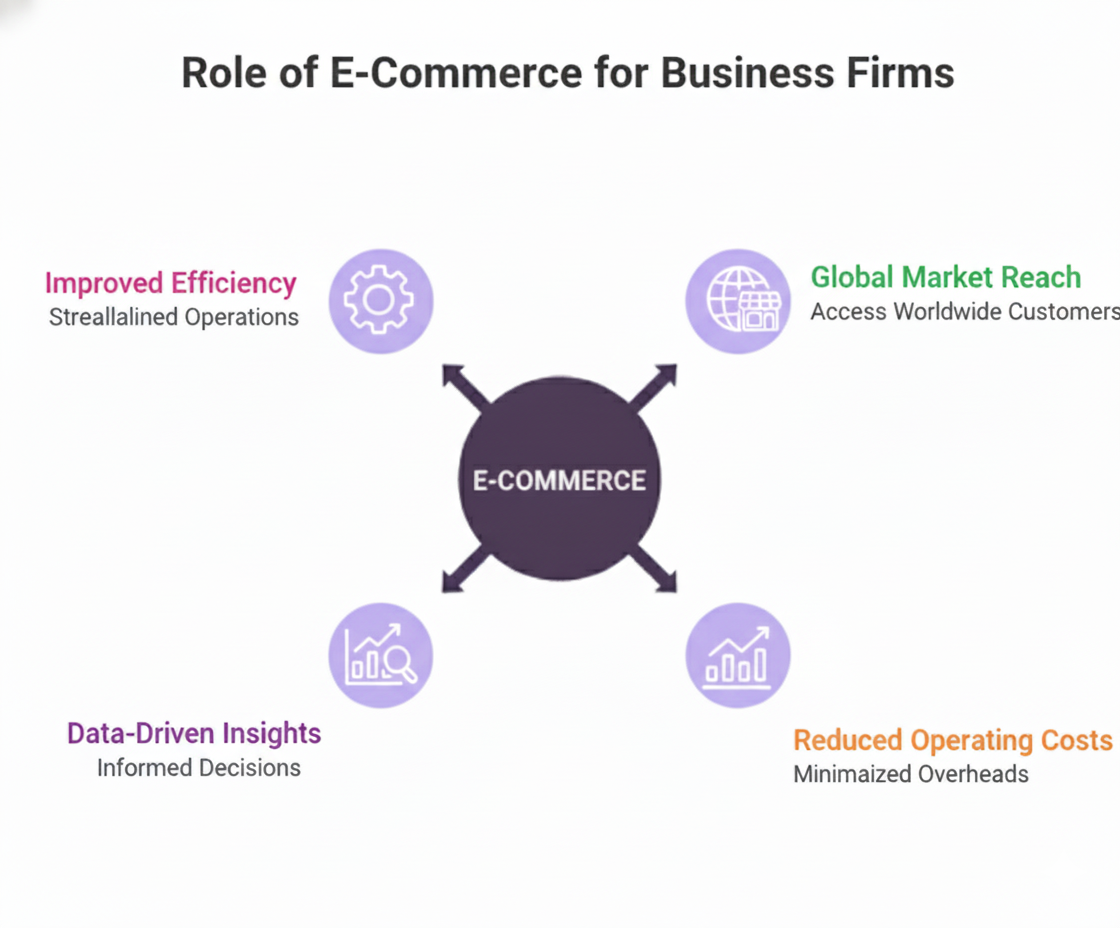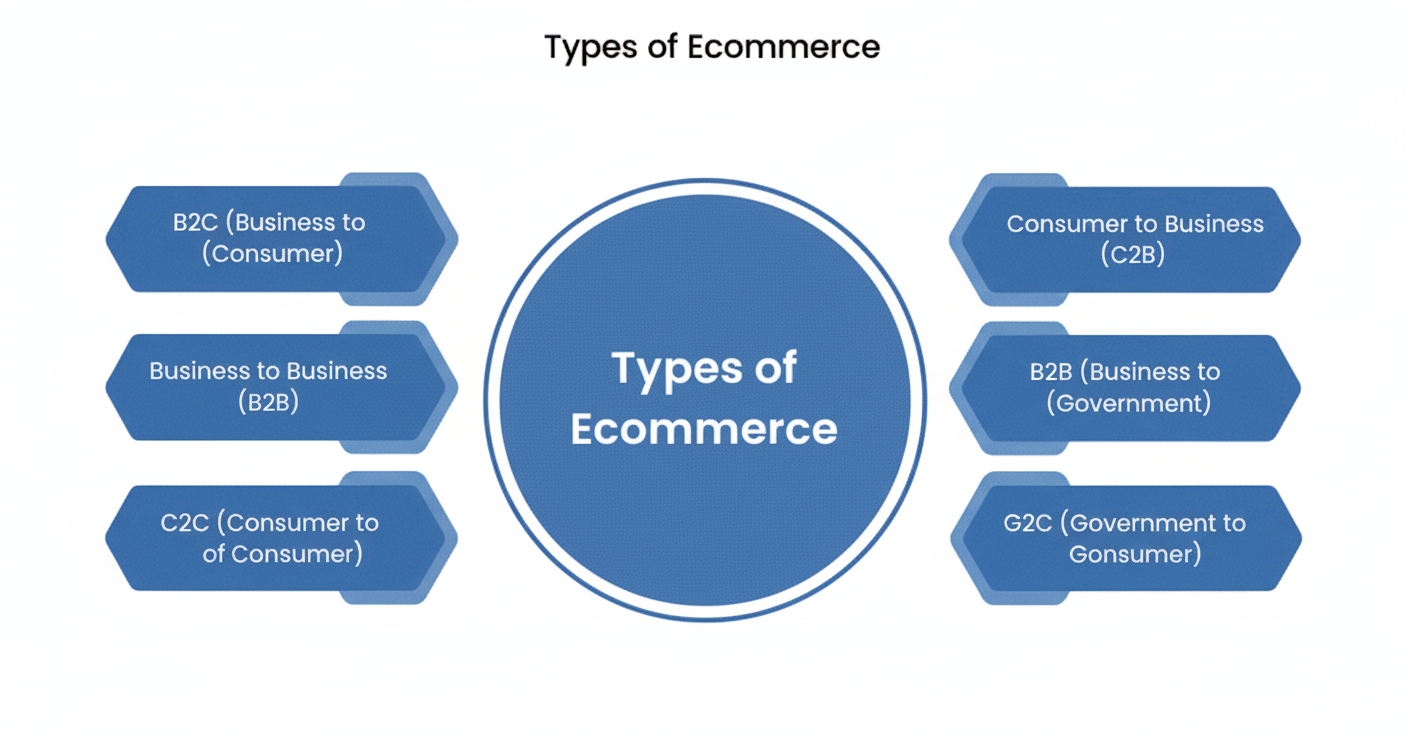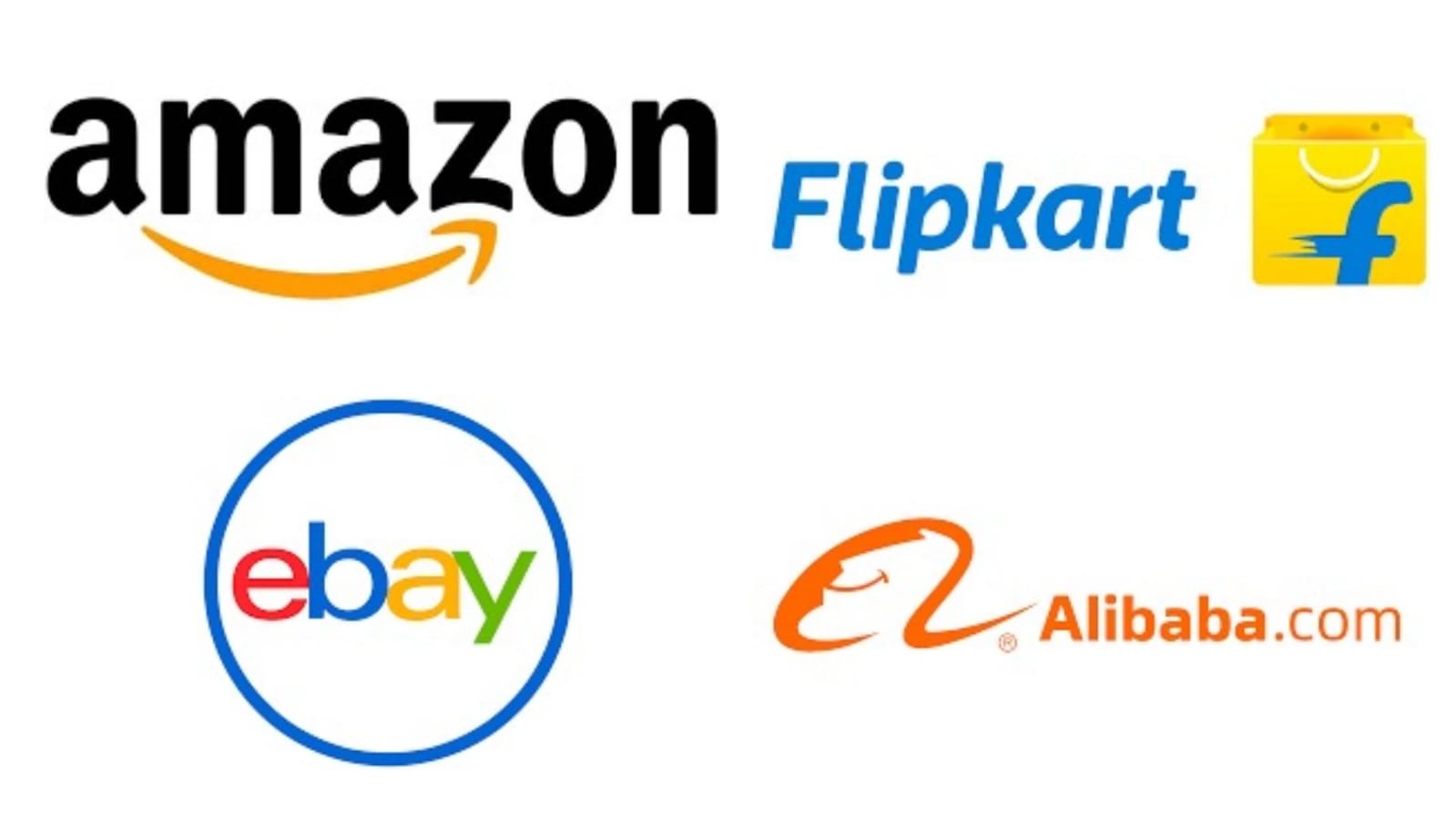Introduction
Electrical Commerce, or E-commerce, is the buying and selling of goods and rendering services over the internet. It enables consumers and businesses to trade online through websites and apps, which are accessible via the internet, eliminating the need for physical stores.
E-commerce can be conducted on computers, smartphones, and other devices, making it easier for people to access it from anywhere in the world. It also allows the business firms to connect to a diverse variety of people around the world instead of being accessible only to local people.
It includes activities like online shopping, digital payments, internet banking, online ticket booking, and services like E-learning. E-commerce plays a pivotal role by transforming the operating activities of a business, offering 24/7 global access to products and services to consumers, and expanding its business globally.
History Of E-commerce
The history of E-commerce began in the 1960s and 1970s when large corporations and government organizations first started using electronic data interchange (EDI) to exchange documents and conduct transactions digitally.
However, the true foundation of E-commerce was laid in the 1990s with the rise of the internet. Until 1991 World Wide Web (www) was accessible to the public, which opened a new window for consumers to shop online on a global scale. By the mid-1990s, companies like Amazon and eBay became the main platforms that were convenient, efficient, and profitable to consumers.
By the 2000s and beyond, E-commerce evolved into a massive global industry, which gave rise to more platforms like Shopify, Flipkart, and Alibaba. Today, E-commerce is not just about buying products but also includes rendering services, subscriptions, digital goods, and providing virtual experiences.
Advantages of E-commerce

- Convenience: One of the biggest perks of e-commerce is its convenience. People can access products and services online as well as sell their own goods and services anytime, anywhere—no closing hours, no long queues, and no need to step out of their comfort zone.
- Global Reach: E-commerce breaks all geographical barriers as it is accessible to a wider scope of audience around the world and provides a global exposure to brands and small enterprises to grow faster and attract more consumers.
- Lower operating costs: Running an online store is far more cost-effective than maintaining a physical one, as a physical one requires a location, staff, and a lot more paperwork, whereas E-commerce offers affordable ways to promote their goods and render services.
- Personalized shopping experience: Online stores can track customer preferences and recommend products based on their browsing or purchase history, or as per the likes and needs of the customers.
Role of E-commerce
E-commerce plays a vital role in shaping today’s Digital Economy. It connects buyers and sellers through online platforms, making trading faster, easier, and more accessible than ever before. Removing the limits of distance and time, it allows businesses to operate 24/7 and reach customers all over the world.
Role of E-commerce for Businesses

- Global Market Reach: Businesses can sell products worldwide without setting up physical stores, expanding their customer base easily, and being accessible 24/7 to customers.
- Reduced Operating Costs: Online operations lower expenses like rent, staff salaries, and utility bills.
- Data-Driven Insights: E-commerce platforms collect customer data that helps businesses improve marketing, decision-making, and future product strategies.
- Improved Efficiency: Automated systems make managing orders, payments, and inventory faster and more accurate as they eliminate the need for repetitive paperwork.
Role of E-commerce for consumers

- 24/7 Convenience: Customers can shop anytime, from anywhere, without time or location limits, as E-commerce platforms are available 24/7 at a global level.
- Wider Choice: E-commerce provides access to countless products and brands that may not be available locally.
- Price Transparency: Easy comparison of prices and reviews helps buyers to compare various prices on other platforms, and customer feedback ensures reliability.
- Comfort and Flexibility: From doorstep delivery to easy returns, e-commerce ensures a hassle-free shopping experience and eliminates the issue of crowds, queues, and the pressure of salespeople.
Types of E-commerce

E-commerce has transformed the way we buy and sell, making transactions faster, easier, and accessible from anywhere in the world. It is categorized based on who is involved in the transaction—businesses, consumers, or the government. Understanding these types helps us see how e-commerce impacts both buyers and sellers in different ways.
- B2C (Business to Consumer) – Businesses sell products or services directly to individual consumers. Examples include Amazon, Flipkart, and Myntra. It’s the most common type, offering convenience, variety, and quick delivery.
- B2B (Business to Business) – Transactions occur between businesses rather than individuals. For example, Alibaba or IndiaMART supply goods in bulk to retailers or manufacturers. These deals usually involve contracts, larger quantities, and long-term relationships.
- C2C (Consumer to Consumer) – Individuals sell goods or services to other individuals through online platforms like OLX or eBay. It’s often used for second-hand products, collectibles, or personal services, making peer-to-peer trading easy.
- C2B (Consumer to Business) – Consumers offer products or services to businesses, such as freelance services on Upwork or stock photos sold to companies. It empowers individuals to monetize their skills or content.
- B2G (Business to Government) – Businesses provide goods or services to government agencies through official tender platforms. Examples include supplying IT services, office equipment, or infrastructure services for public projects.
- G2C (Government to Consumer) – Governments deliver services directly to citizens online, such as e-tax filing, digital certificates, and social welfare schemes. It increases transparency, saves time, and reduces paperwork.
Examples of E-commerce

E-commerce has revolutionized shopping, making it possible to buy and sell products and services online from anywhere in the world. Various platforms have emerged to connect businesses, consumers, and even individuals with each other efficiently. Here are four of the most popular e-commerce platforms
Amazon: One of the largest global B2C platforms, Amazon sells everything from electronics to groceries. It is well known for fast delivery, a wide product variety, and a convenient shopping experience.
Flipkart: A major Indian e-commerce site offering electronics, fashion, and home goods. Famous for discounts, festive sales, and hassle-free returns, it’s one of India’s top online marketplaces.
eBay: A platform where individuals and businesses can buy or sell new and used items. Popular for auctions, collectibles, and second-hand goods, it combines C2C and B2C models.
Alibaba: A leading B2B platform connecting businesses with manufacturers and suppliers worldwide. Mostly used for bulk purchases and wholesale trading, it’s ideal for exporters and retailers.
Conclusion
E-commerce has transformed the way businesses operate, providing a global reach and opening new markets and opportunities for buyers and sellers. It allows companies to sell products faster, reduce costs, and maintain better customer relationships.
For consumers, it offers convenience, flexibility, and a variety of choices at their fingertips. Shopping online saves time, allows easy price comparisons, and brings products directly to their doorstep.
Overall, e-commerce plays a vital role in today’s digital economy, bridging the gap between businesses and consumers. Its growth continues to shape trade, innovation, and everyday life worldwide.
